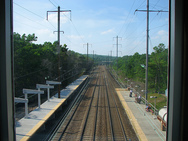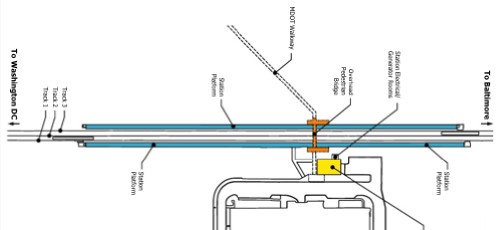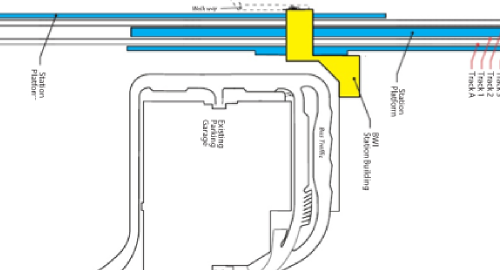Maryland plans a new station at BWI and other projects to run more trains

Photo by Elvert Barnes on Flickr.
Maryland’s Mass Transit Administration is planning upgrades to the Amtrak/MARC station at BWI Airport along with several other projects along the Washington-Boston Northeast Corridor within the state. The projects will make Amtrak and MARC trains in the area more reliable as well as allow more trains to pass through the overcrowded rail corridor.
The project will reconfigure the station to have four mainline tracks, each with access to a platform. It will also include a nine-mile fourth track that will run alongside the existing ones, and a new station building with a larger waiting room.
The proposal is currently undergoing an assessment to determine how it would affect the environment. If MTA can get the funds and further environmental review isn’t necessary, the final design process could start next year. Even then, though, construction probably wouldn’t start until 2017 or 2018 at the earliest.
A lot of people use the BWI station, which isn’t built to handle them all
The current BWI Airport rail station is served by Amtrak and MARC trains on the busy Northeast Corridor. On top of being a popular way to get to the airport, the station also gets heavy use from commuters because it has two parking garages with over 3,000 parking spaces.
The problem is that the station’s layout is inefficient, and it’s operating above its designed capacity. The station has two platforms on either side of the three-track Amtrak main line. In order to service the station, trains must be on one of the outside tracks, which reduces operational flexibility.
It can be problematic because even the limited-stop Acela Express trains occasionally stop at BWI. Also, the location of interlockings, where trains can change tracks, means any train serving the BWI station has to run on the outside track for 9 miles, from Odenton to Halethorpe.
Fast trains, like the Acela, share the railroad corridor with slower Northeast Regionals and commuter trains making local stops. If an Acela or Regional needs to stop at BWI, it has to be on the local track, and that can mean getting stuck behind a slower MARC train (or having dispatchers hold the MARC train so the higher-priority Amtrak train can pass it before getting on the local track).
With a four-track station, fast trains on the center tracks won’t have to slow down to switch to the local track or mix with commuter trains. That will make it easier for Amtrak to schedule stops for the faster trains. And with fewer conflicts, will allow more MARC trains.
Ridership at the BWI rail station has dwarfed its capacity to handle the crowds. When the station opened in 1980, it was primarily designed to serve the two MARC trains in each direction that operated between Baltimore and Washington. The waiting room only seats 40 people. Today, more than 32,000 passengers use the station each day. Just under 60% of those are MARC riders; the rest are Amtrak customers.
Correction: It appears the 32,000 number, which comes from the Environmental Assessment documentation, was part of a poorly phrased paragraph. The 32,000 passengers referred to count those who use the station and also counts anyone who passes through on a train without boarding or alighting. Sorry for the confusion.
Another constraint is the track arrangement. Right now, the section of track sees 92 Amtrak trains and 56 MARC trains each day. But by 2030, expected service levels will rise to 110 Amtrak trains and 135 MARC trains, an increase of 66% from 148 to 235 trains.
Building a new station
The new station will have four tracks, each with access to a platform. The existing southbound side platform will remain in its current location. The current northbound side platform will be enlarged into a center platform, and a new northbound side platform will be constructed alongside the new fourth track.
When completed, the new four-track segment will tie into an existing four-track segment that runs between Halethorpe and West Baltimore. That will mean the corridor will have a 14.5-mile segment of four tracks, greatly increasing operational flexibility and redundancy.
The project’s status
The Federal Railroad Administration is leading an environmental assessment (EA) to determine whether the likely impact of the project will require a full Environmental Impact Statement (EIS) or if it can go to design and engineering without that step. The EA is scheduled to be finish this summer.
If the result of the EA is a “Finding of No Significant Impact” (FONSI), the project will be able to proceed directly to engineering and design if funding is available. If an EIS is required, however, that process will probably take about two years to complete. The design phase and the process of selecting a contractor will probably take another two years.
During construction, at least two tracks need to be open to traffic, each with access to a platform. That means it will take three and a half years to complete the project. Certain parts of the project, including the new station building and larger waiting room, should be finished in about two and a half years.
The estimated costs for the project, including nine miles of new track, two new platforms at BWI, and a new station building is approximately $540 million. Funding sources haven’t been identified, but will likely be a combination of funding from the federal government, Amtrak, and the state of Maryland.
Other projects are in the works
In addition to the BWI improvements, Maryland, Amtrak, and the Federal Railroad Administration are working on several other projects that will help rehabilitate and expand infrastructure on the Northeast Corridor. Some of these projects have been on Maryland’s wish list for several years.
Between West Baltimore and Baltimore Penn Station, the corridor runs through the B&P Tunnels, which were built in 1873 and are badly in need of repair and replacement. The tunnels have a speed limit of 30 miles per hour and the four-track segment has to narrow down to two tracks, creating a bottleneck.
The replacement of these tunnels is currently undergoing the environmental review process and doesn’t have funding. If that changes, the project will construct a new two-track tunnel to replace the B&P Tunnels. Once it’s complete, the older tunnels will be shuttered for an overhaul and then later returned to service.
Amtrak is also studying the replacement of the Susquehanna River Bridge, which carries trains across the wide river just above its mouth. It was built in 1906 and is also badly in need of repair. The current proposals will replace the two-track span with two two-track spans, enlarging the corridor to four tracks here.
The replacement is not currently funded beyond the study phases, but getting through the environmental process is a necessary step for getting the project to “shovel-ready” status and making it eligible for federal funding.
Two more much-wanted projects do not have funding, even for environmental studies. Amtrak also needs to replace long bridges over the Bush and Gunpowder Rivers north of Baltimore. Maryland applied for federal funding from the American Recovery and Reinvestment Act several years ago for studies of these bridges, but the request was unsuccessful.
These infrastructure projects are a huge part of ensuring the economic vitality of the Boston-Washington corridor. Currently, Amtrak carries three quarters of the Washington—New York air/rail market, and that share is only growing. Much of the infrastructure in the corridor is now over a century old, and suffers from deferred maintenance.
Amtrak and the commuter railroads, like MARC, that ply the corridor want to increase capacity by running trains more frequently. But without investments in infrastructure, that won’t be possible. And in fact, if certain projects, like the Gateway Project in New York and New Jersey, are not completed, capacity may actually be lower than it is now.


